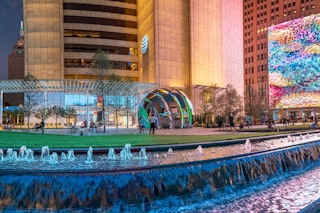Historic Landmarks and Sites
Step back in time and take in all of Dallas' rich history.
Founder's Plaza
A must-see in Dallas, Founder’s Plaza tells the origin story of the city and features several historical structures and landmarks in Downtown Dallas. See a replica of the Dallas founder John Neely Bryan’s cabin, view a terrazzo map of Dallas County in the 1800s and learn about the first settlers in Dallas.
Old Red Museum And Courthouse
Also located in Founder’s Plaza in Downtown Dallas, the Old Red Museum and Courthouse contains some of Dallas’ most fascinating historical artifacts, photographs and mementos in a comprehensive exhibit detailing Dallas’ county’s history. In addition to the exhibit, see some of the building’s original features like the steel vault, the grand staircase and more than one hundred stained glass windows.
Bath House Cultural Center
Originally named the White Rock Bath House, this center was one of the first uses of art deco architecture in the Southwest and drew in thousands of people during the 1930s. Today, instead of showers and changing rooms, the Bath House Cultural Center houses an impressive theater and two gallery spaces to showcase local artists work and performances, which are on display year-round.
Dallas Heritage Village
Located in the Cedars/ Southside neighborhood, Dallas Heritage Village exhibits a collection of original, historic structures and furnishings built in Dallas from 1840-1910. Featuring the largest collection of original buildings in Dallas, as well as plenty of interactive exhibits, memorabilia and classes, this village gives a full-on glimpse of life in Dallas during the 19th century.
Degoyler House & Garden
A beautiful, picturesque white Spanish Colonial-styled house, the DeGoyler House was the estate of petroleum industry tycoon, Everrette DeGoyler, and known for its impressive and massive library. The house has much of its original garden features still intact and is available for tours at the Dallas Arboretum and Botanical Garden.
Fair Park
With the nation’s largest collection of 1930s art deco-styled buildings, as well as more than 3 million historic documents and artifacts displayed at the Hall of State at Fair Park, the park is a notable attraction in Dallas and is packed full of history. It’s also the site of the annual State Fair of Texas, welcoming more than one million visitors from all around the world each year.
Freedman's Cemetery Memorial
Representing a significant part of Dallas history, this landmark serves as a burial ground for Dallas’ early African American community post-Civil War and is one of the largest Freedman Cemeteries in the U.S. Stop by the beautiful landmark and learn about Freedman’s town, a small and segregated African American community in north Dallas, which is now known as Uptown.
John F. Kennedy Memorial Plaza and The Grassy Knoll
Stop by the John F. Kennedy Memorial after a visit to the Sixth Floor Museum for a time of reflection. The memorial honors the late president with a minimalistic monument that’s open for public viewing daily. Also, just one block away for viewing and reflection is the infamous ‘grassy knoll,” a small hill that become well known after the death of former president John F. Kennedy.
Texas Theatre
Opened in 1931 in Oak Cliff, the Texas Theatre is a big part of Dallas’ rich history. A staple in the community, the theatre is known for its Venetian-styled architecture and being the first theater in Dallas with air conditioning. The theatre also gained international attention for being the hiding spot for infamous Lee Harvey Oswald in 1963. While the original seats are gone, you can still see where Oswald snuck in and sat down or catch one of the classic movies shown here daily.
Lakewood Theater
Built in 1938 in Old East Dallas, Lakewood Theater is an iconic landmark in Dallas and most recognizable by its 100-foot-neon tower and art deco architecture. While the theater has been renovated to an upscale bowling alley, it still displays its original and imaginative murals depicting Disney characters, as well as princes, soldiers, dancers for a fun, whimsical experience.
Majestic Theatre
With a big, exquisite and well-lit sign, the Majestic Theatre (known to locals as simply “The Majestic”) is hard to miss. Originally opened as a vaudeville theater in the 1920s, the theatre was a hotspot in town and hosted a variety of movie premieres with big stars like Gregory Peck, John Wayne, Jimmy Stewart and more. Today, the theater hosts a variety of plays, musicals and other live performance among the space’s beautiful architectural features.
Pike Park
Take a stroll at Pike Park in Uptown. The 4.3-acre park and historical landmark was established in 1913 and was originally called Summit Play Park, a nod to its roots as a central gathering area in the neighborhood. Later, the neighborhood became known as “Little Mexico” as thousands of Latin Americans came to the area and one of only three buildings with a Mexican-American history to be declared a Dallas Historical Landmark.
More History & Museums










